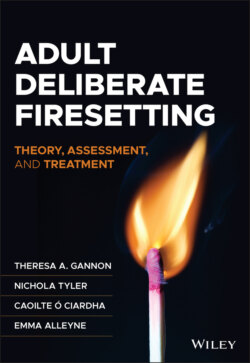Читать книгу Adult Deliberate Firesetting - Theresa A. Gannon - Страница 13
Adult Firesetting as a Neglected Topic of Research
ОглавлениеResearch examining the psychological factors underpinning firesetting behaviour and treatment for firesetting has undergone a sea change in the past decade or so. Prior to this, research on adult firesetting appeared occasionally in the literature and had relatively minimal impact. However, since the publication of a review of the state of the literature by Gannon and Pina in 2010, there have been year-on-year increases in the number of outputs on firesetting, which have impacted on the wider psychological and criminological literature. Even older papers (e.g., Inciardi, 1970; Jackson et al., 1987) have seen notable increases in rates of citation in the past decade as a new generation of researchers revisits these canonical sources. It appears that sustained research from a number of research teams (especially in the UK and Australia) from 2010 onwards resulted in a critical mass for the topic. This critical mass was likely brought about by researchers and research funders recognising that adult firesetting reflects a major public health and criminal justice concern with a large human and financial cost.
The neglect of adult firesetting as a research topic likely stems from an interaction of factors. First, research on firesetting has historically focused on firesetting behaviour in children and adolescents. We will explore the reasons for this and the contribution of this literature to the understanding of adult firesetting. Second, it appears that there was a general belief that firesetting could be explained by either mental disorder (i.e., pyromania) or by general criminality (e.g., people setting fires to claim insurance or destroy evidence). Given that diagnoses of pyromania are exceptionally rare, there may have been a belief that firesetting behaviour was mostly addressable through general criminal offending programs. Readers of this book will see that the evidence base now suggests that many individuals who set fires have unique characteristics (see Chapter 2) requiring tailored risk assessments (see Chapter 4), and crucially, would benefit from interventions designed to target their distinct treatment needs (see Chapters 6 and 7).
